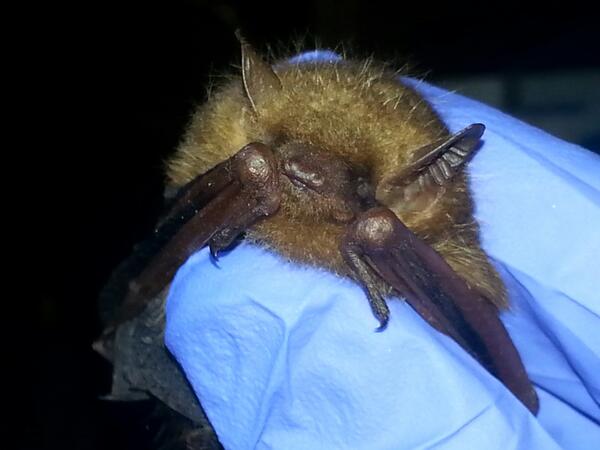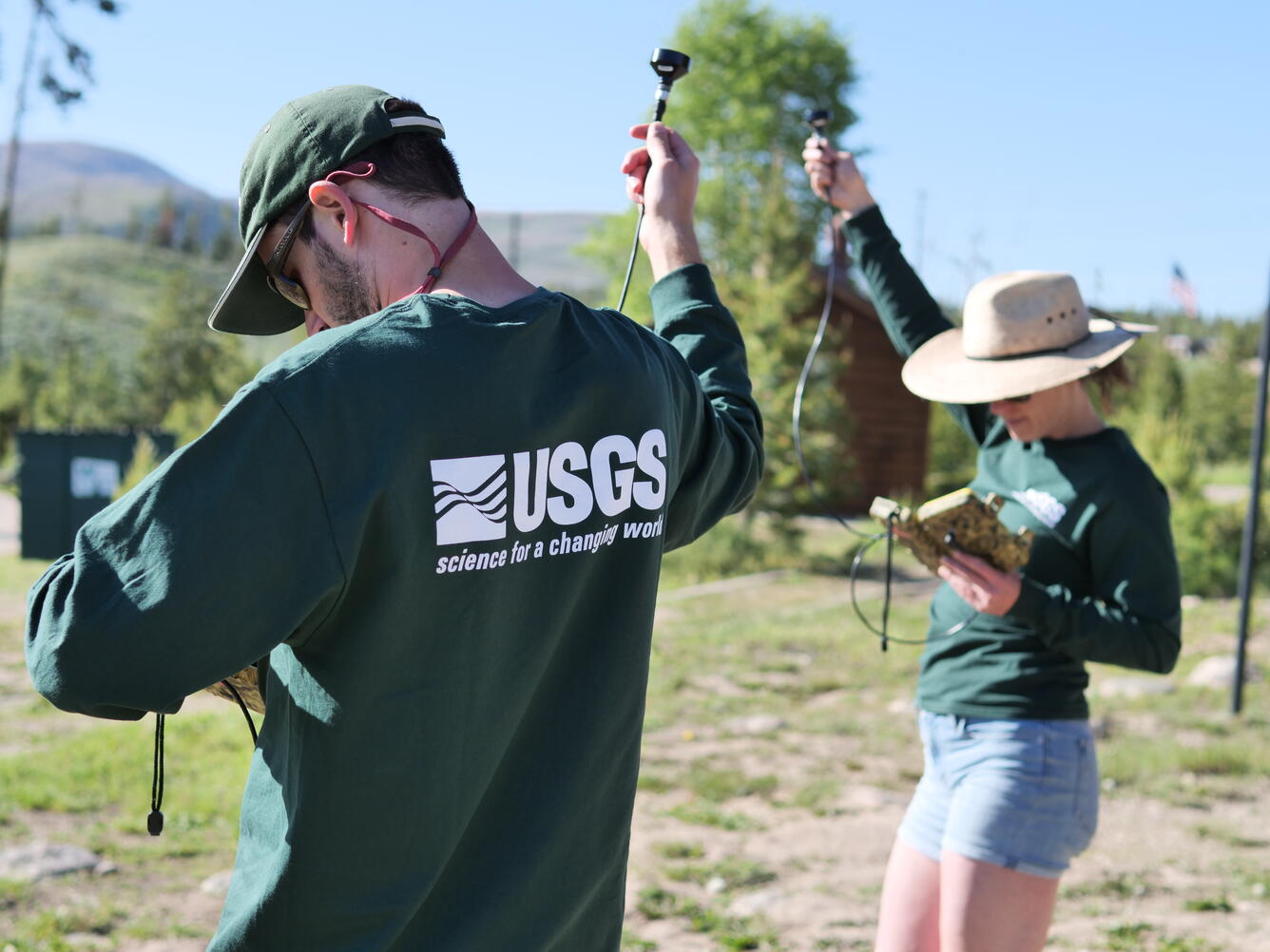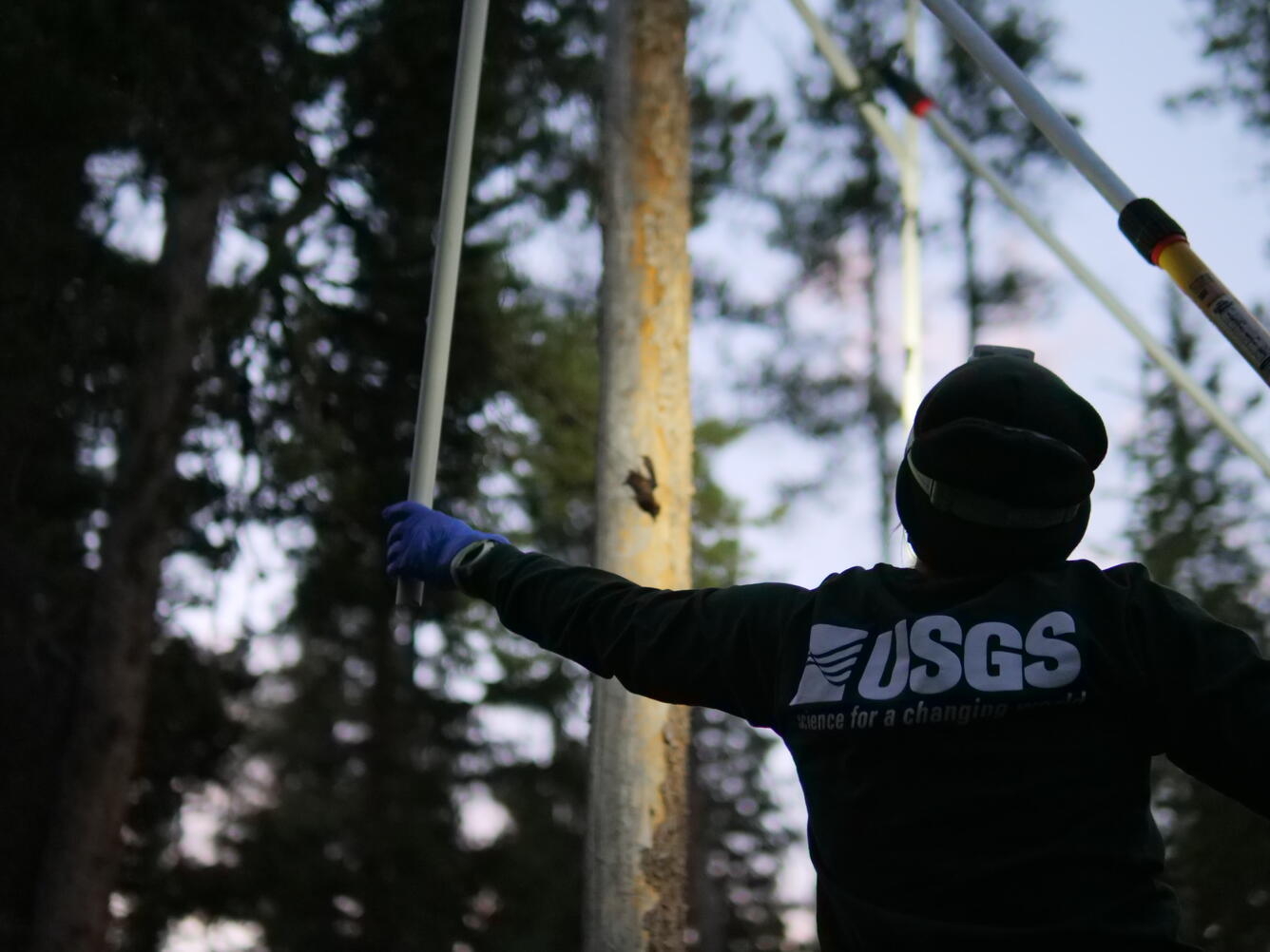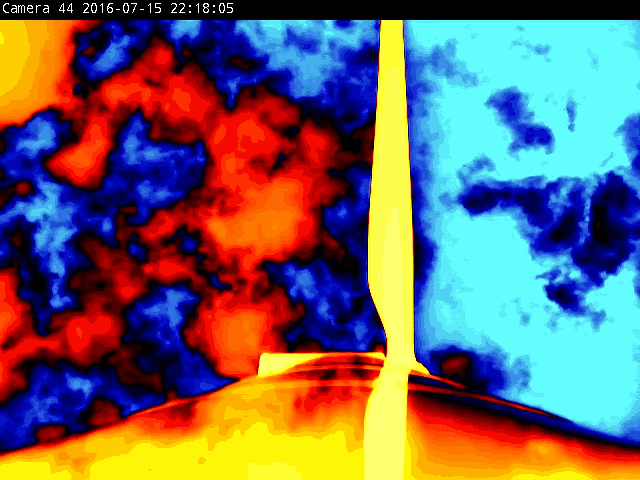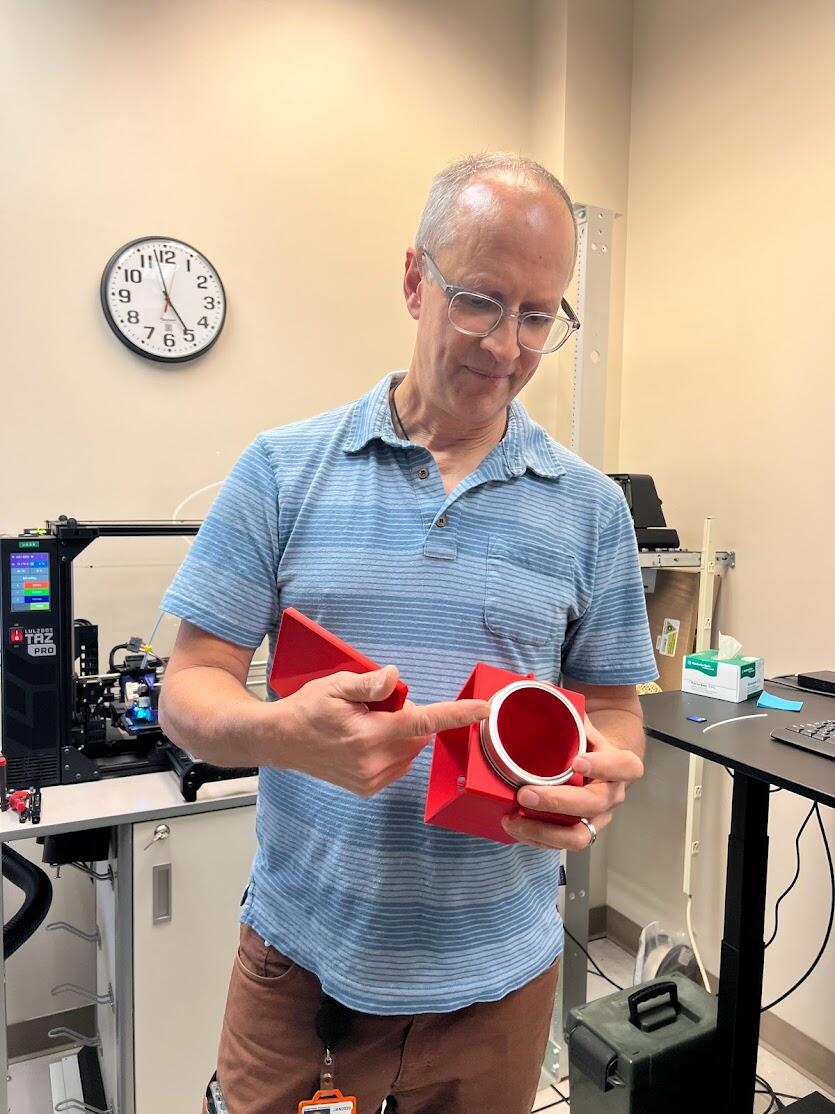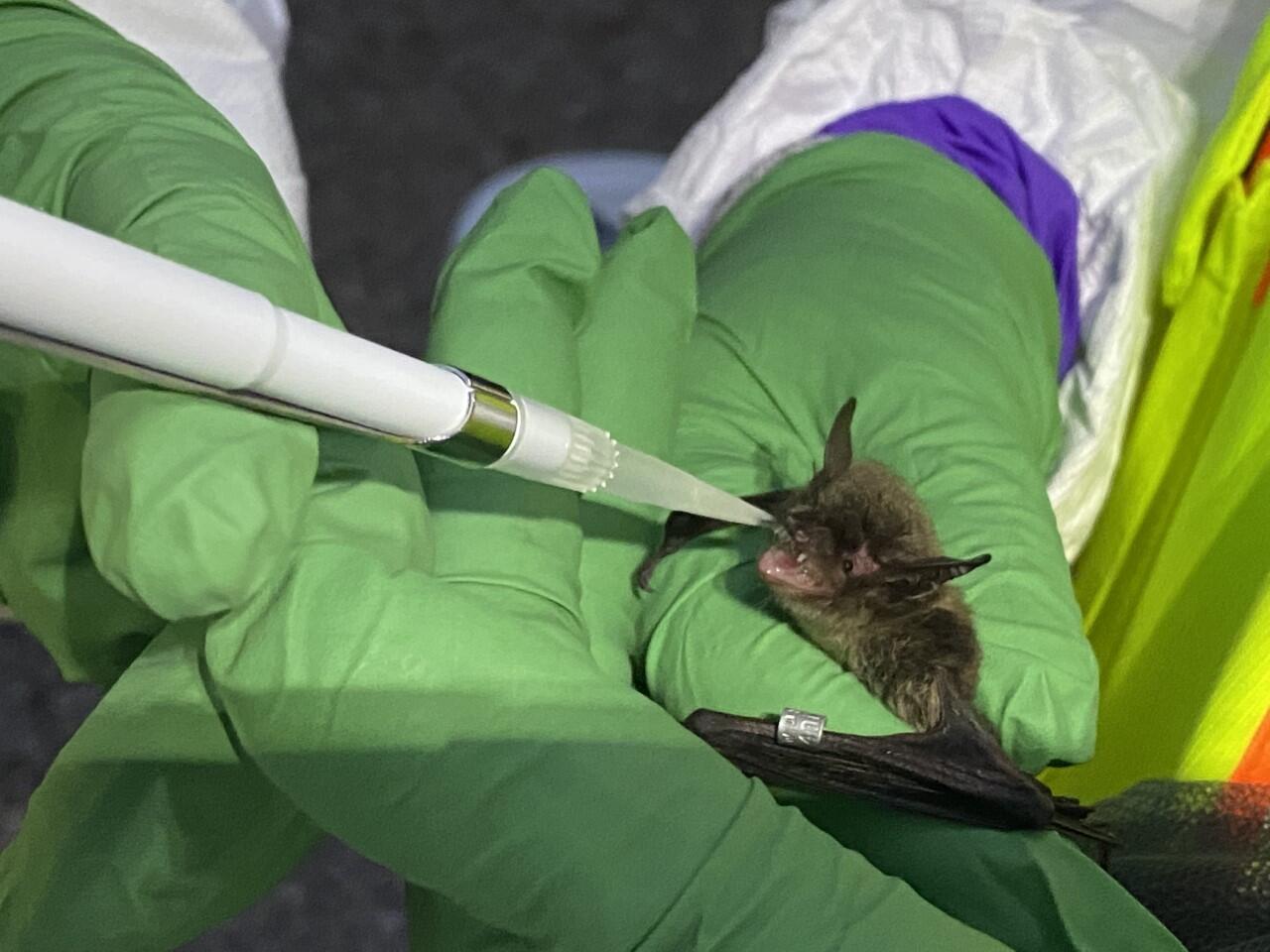Fire up the 3D printer! It’s 2024 and it’s time to study some bats!
From wooden boxes and nets to 3D printers and gene editing, USGS scientists use tools old and new to tackle the tricky problems of bat science
Bats don’t make it easy to study them. How do you study an animal that is small enough to fit in your hand, blends well into its surroundings, only active at night, has a call that humans can’t hear, and spends much of its time well-hidden in caves and trees?
But bats are really important! They pollinate plants that produce over 300 species of fruit, as well as agave (the plant tequila and mezcal are made from) and spread the seeds of figs, cacao (the main ingredient in chocolate) and other nuts. Bats also provide pest control by eating enormous numbers of insects, which benefits the agriculture and lumber industries—studies have estimated the value of bats to agriculture to be \$3.7 billion. One study recently suggested that sharp declines in United States bat populations were correlated with insecticide use and an associated rise in human infant mortality.
Given their importance, we can't hole up in a cave and avoid studying bats because it’s too hard! Instead, chiropterologists (bat scientists) have to get creative. Some of the methods used by USGS bat scientists have been around for a long time, like setting up big nets to capture bats, or counting bats as they emerge from a roost. But other methods rely on the latest technology, and USGS scientists are innovators, constantly coming up with and testing out new strategies for studying bat biology.
Here are 10 exciting tools that USGS bat biologists are using or developing to learn about bat biology and develop science-based approaches for bat conservation:
The Oldies But Goodies
If it ain’t broke, keep using it. Acoustic bat detectors, mist nets, and bat houses have been the foundation of bat research for decades, and they still are, even as new tools help scientists process, manage, analyze, and share data collected with these classic approaches.
1. Bat detectors that listen for ultrasonic calls
Long one of the main workhorses of bat biology, bat detectors, or acoustic monitors, listen for the calls of echolocating bats and other bat sounds. Most bat calls are at too high a frequency to be heard by the human ear, but these devices can detect and record them. Then, researchers can visualize the patterns of the calls, or adjust the frequency so that humans can hear them.
Like birds, different bat species have different calls, and they make different sounds when engaging in different behaviors, so scientists can identify species and other information from the calls by using specialized bat call identification software. Records from acoustic monitoring help bat biologists estimate population sizes, habitat ranges, and more.
Background image: Andrea Schuhmann examines an acoustic bat recording using a software for bat call analysis (Frankie Tousley, USGS).
2. Really big nets, strategically placed
Mist nets have long been a primary tool for capturing both birds and bats for research. These large, thin, mesh nets are hard for people to see. The bats can still see or detect the nets through echolocation, though, so researchers try to place nets in inconspicuous locations where the bats unknowingly fly or emerge into the nets.
They are stretched between trees or other structures in areas where bats fly, set up such that bats flying through are funneled into the net. They are often set up over water, where bats fly low to hunt for insects or to drink water. Bat biologists will carefully disentangle bats from the net before processing the bat (taking measurements or performing procedures like attaching a tag or vaccinating the bat) and eventually releasing the bat.
Background image:
Biologists set up a triple-high mist net to capture bats with El Capitan, one of Yosemite's most iconic rock formations, in the background, as part of a study to track bats in Yosemite (Austin Waag, USGS).
3. A bat in the belfry? No, a bat in the bat house!
Bats naturally roost in caves or trees, but they also commonly use human-built structures like old buildings and bridges. In some places, people have built wooden bat houses (or bigger bat condos) to encourage bats in areas where roosts may be hard to find or to deter bats from historic buildings by providing an alternate roost site.
For researchers, bat houses or condos can be great sites to conduct research or capture bats for vaccination. Researchers working on vaccines for white-nose syndrome envision eventually being able to deploy the vaccine by spraying roosts, including bat houses and bat condos, so that bats don’t need to be captured.
Background image: bats roosting in a bat box. (Frankie Tousley, USGS)
The Internet of Bats
While old tools are still essential, the power of the internet and big data are helping scientists gather, process, and make available more bat data than ever before.
4. An interactive map and database of bats
The USGS leads the North American Bat Monitoring Program, or NABat, an international interagency program designed to monitor bat distributions and abundances on public and private lands, with the goal of providing data to inform bat management and conservation. Partner organizations share bat observation data with one another, largely from acoustic monitoring, and have since built an enormous database.
As of October 2024, the NABat database has over 100 million uploaded acoustic records, as well as nearly 50 million capture, internal roost survey, and emergence counts. In the NABat Partner Portal, users can visualize bat observation records on a map across North America and sort available data by location, species, data type, and date. With so much data now available, USGS researchers in the NABat program are now incorporating machine learning to help process the data, developing software that can identify bat species from audio files.
Background image: a screenshot of the NABat Partner Portal interactive map.
5. An interactive map and database of … not bats?
Sometimes bat researchers need a map of where bats are located, sometimes they need a map of something completely different, like wind turbines. The US Wind Turbine Database might not include bat-specific data, but it’s a key tool for understanding the threat wind energy may pose to bat populations and how wind energy developers can minimize bat mortality.
By looking at the overlap between bat habitat and the locations of wind energy, USGS scientists have identified where and during what times of year Mexican free-tailed bats are most at risk from wind turbines. Energy developers can then use this information to determine how strategies like slowing turbine speeds can be used most effectively to minimize collisions with bats.
Background image: a screenshot of the US Wind Turbine Database.
6. Tiny transmitters that weigh as little as a raindrop
Until recently, it’s been difficult to track individual bat movements over long distances or time periods, since they are too small to carry the heavier GPS tags used for other mammals and large birds. But a new type of animal tracking technology, which uses tiny, lightweight nanotags that can be affixed to small flying animals like bats, birds, and even dragonflies, has made the task much easier.
The tags are part of the Motus Wildlife Tracking System, run by an international collaborative research network. The Motus network is made up of arrays of more than a thousand automated radio telemetry receiving stations around the world that detect signals from tiny tags worn by animals. USGS scientists are using Motus tags to track bats in Washington and California for studies that inform white-nose syndrome monitoring and management, and along the California coast, the data will inform planning for offshore wind energy.
Background image: Hoary bat with a Motus tag (USGS).
7. Hot videos (from temperature-sensing cameras)
Hibernating bats can spend more than half the year inactive in caves or other dark, difficult to access hibernation locations (hibernacula). Understanding what goes on during hibernation is not only important to understanding a bat’s life history, but hibernation is also when bats are most at risk from white-nose syndrome—the disease disrupts hibernation, causing bats to exhaust their energy stores and die.
USGS researchers have placed remote, weatherproof temperature-sensing cameras in hibernacula to observe bat behavior during this time of year, in one study collecting nearly 18,000 hours of video (they also developed software to help process all that video). The thermal cameras, which can detect bats and their movements in the dark, showed how two different species behave during hibernation, which may influence their differing susceptibility to white-nose syndrome. Thermal cameras have been used to study other kinds of bat behavior at night, too, like bat interactions with wind turbines.
Background video: Thermal imagery shows a bat approaching a wind turbine tower (USGS).
If You Make it, Bats Will Come (And Be Protected from Disease)
USGS scientists are innovators, developing and testing creative new ways to study bats rooted in the latest biomedical and industrial tech.
8. 3D printers that make bat detecting tools more accessible
There are lots of cool tools to study bats, but tools like bat detectors are expensive, which can limit how many of these devices scientists can deploy and how much data they can gather. USGS scientist Paul Cryan is trying to solve this problem with 3D printing. 3D printing allows you to design, test, and build bat audio and video recording devices, more cheaply and accessibly, and customize it to your specific needs. The 3D printed tools are made of recyclable materials and are waterproof and hardy—perfect for field conditions.
Background image: Paul Cryan shows off some of his 3D-printed bat research tools (Allie Weill, USGS).
9. A CRISPR-based sensor that can detect the agent of a deadly bat disease
CRISPR is a powerful gene editing technique that can edit the DNA of living organisms. Since this technology is precise, cheap, and relatively easy, it has many applications in biotechnology and medicine. One way CRISPR can be used is in the detection of disease—including wildlife disease. Last year, USGS scientists published a paper describing how CRISPR technology can be used to detect the fungus that causes white-nose syndrome in bats, a disease that has killed millions of bats across North America. The tool is minimally invasive and can be used to detect the pathogen from skin swabs of bats in the field. The technique is among the first applications of CRISPR technology to the detection of wildlife disease.
Background image: Fluorescence readout of CRISPR white-nose syndrome biosensor results. Samples that fluoresce indicate the presence of Pseudogymnoascus destructans (Pd; the pathogen that causes white-nose-syndrome) DNA (USGS).
10. Vaccines that bats give to each other by grooming
Sure, bats, like many animals can spread disease to one another when they are in close proximity, by touching and grooming one another. But did you know that bats may also be able to spread vaccines to one another in this way? USGS scientists have been field-testing a vaccine for white-nose syndrome for the past few years. The initial version of the vaccine was administered orally, by pipetting the vaccine into the mouths of each bat one-by-one. That takes a long time, and it requires capturing and directly interacting with each bat.
Now, USGS scientists are working on a different approach: topical vaccines that bats can spread to one another when they groom each other. So far, they have applied topical vaccine to individual hand-captured bats, but the ultimate goal is to develop a method to spray the vaccine on structures bats use, like bat houses, to minimize disruption to bats and apply the vaccine more efficiently. This year, they have been testing the potential delivery medium, which doesn’t contain the vaccine yet, but contains a biomarker that will help scientists assess uptake by bats and whether it can work for the vaccine.
Background image: Bats showing signs of infections with Pseudogymnoascus destructans, the fungus that causes white-nose syndrome. (Kimberli Miller, USGS).


